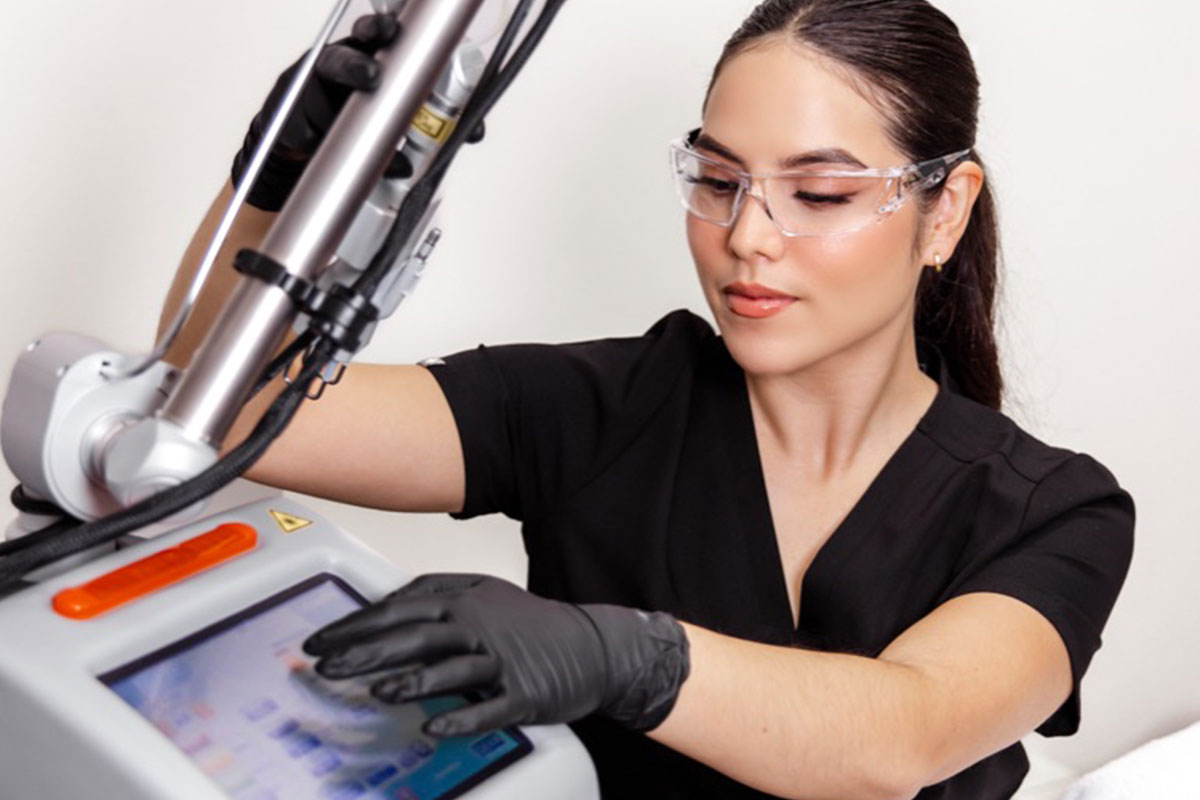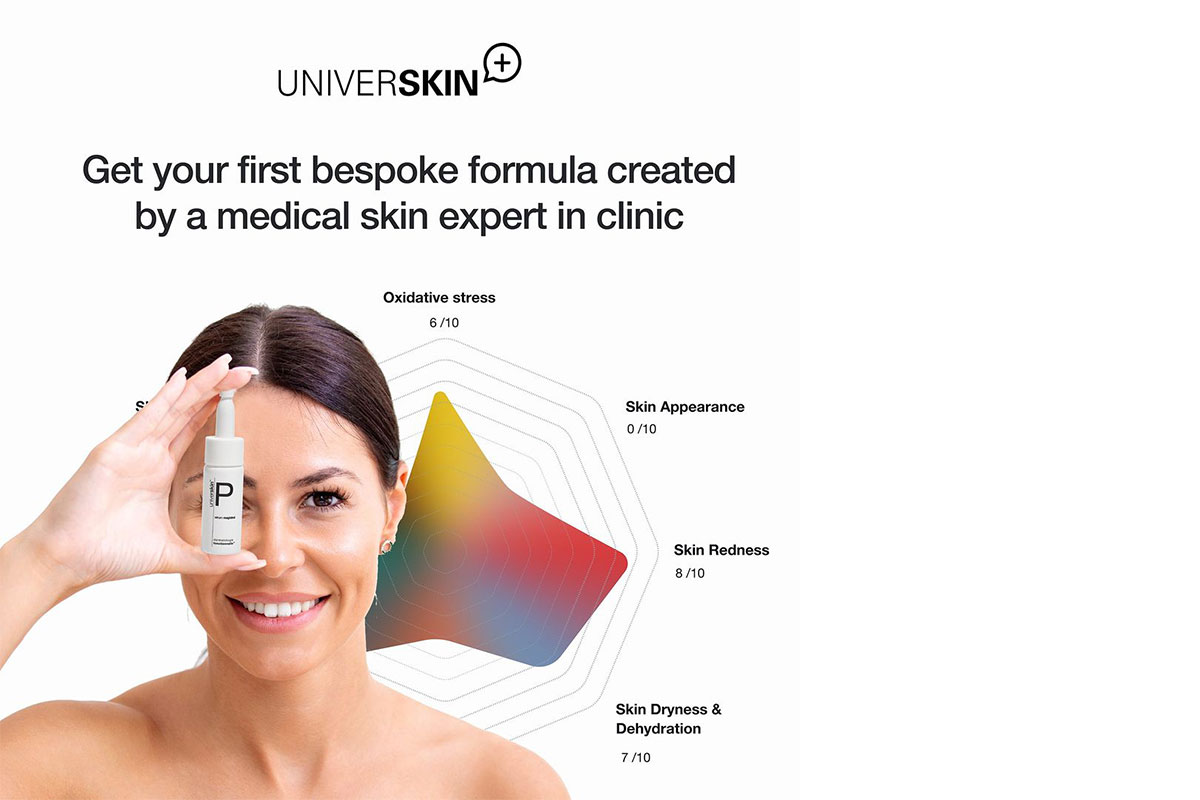Melasma
Melasma
HORMONAL PIGMENTATION & GENETICS
Melasma is a common skin condition characterised by patches of dark discolouration that typically appear on the face, particularly on the cheeks, forehead, bridge of the nose, and above the upper lip.
It often develops gradually and is more prevalent in women, especially those with darker skin tones, and often occurs due to overproduction of melanin by melanocytes, the cells responsible for skin pigmentation.
Sun exposure is a significant factor, ultraviolet (UV) light stimulates the production of melanocytes, cells that produce pigment, leading to increased melanin production in the affected areas. Hormonal changes also play a role – fluctuations during pregnancy, oral contraceptive use, or hormone replacement therapy can trigger melasma. Genetic predisposition is another factor – individuals with a family history of melasma are more likely to develop it themselves. Additionally, certain cosmetics, toiletries, and medications may make the skin more sensitive to UV light and contribute to melasma formation.
Melasma can be triggered or exacerbated by hormonal changes (such as pregnancy or birth control pills), sun exposure, and sometimes by genetics. Melasma does not cause any other symptoms besides cosmetic concerns.
Managing melasma involves daily use of broad-spectrum sunscreen, wearing wide-brimmed hats, and avoiding prolonged sun exposure. Treatment options include topical medications like hydroquinone, tretinoin, and corticosteroids, as well as procedures such as chemical peels and laser therapy, although results can vary widely.

At our Perth clinic, Academy Face and Body brings extensive expertise in facial aesthetic treatments, providing surgical, non-surgical, laser and dermal options tailored to diverse skin types and concerns. Commitment to skincare is crucial for maintaining skin health and addressing specific issues. Our dedicated team conducts thorough assessments to craft personalised treatment plans, ensuring your skin achieves its intended radiance.
WHAT IS MELASMA?
Melasma is a common skin condition characterised by brown to gray-brown patches typically appearing on the face. It primarily affects women and is often associated with hormonal changes, making it more prevalent during pregnancy or with the use of hormonal contraceptives.
It can also occur on other parts of the body that are exposed to the sun, such as the forearms and neck.
Melasma develops when melanocytes, the cells responsible for producing pigment in the skin, become overactive and produce excess melanin. This excessive pigment accumulates in the skin, causing the characteristic patches.
Sun exposure and genetic predisposition also play significant roles in its development.
Causes and Triggers of Melasma
Sun Exposure
Ultraviolet (UV) light from the sun stimulates melanocytes, the pigment-producing cells in the skin, leading to the overproduction of melanin. This overproduction results in the dark patches characteristic of melasma.
Hormonal Changes
Melasma is often linked to hormonal fluctuations. Pregnant women frequently develop melasma, a condition referred to as “chloasma” or “the mask of pregnancy.” Birth control pills and hormone replacement therapy can also trigger melasma.
Genetic Predisposition
There is a hereditary aspect to melasma. Individuals with a family history of melasma are more likely to develop the condition.
Skin Type
People with darker skin tones are more prone to melasma due to having more active melanocytes compared to those with lighter skin.
Medications and Cosmetic Products
Certain medications, particularly those that increase sensitivity to sunlight, can trigger melasma. Some cosmetics and skin care products can also cause photosensitivity, exacerbating the condition.
RECOMMENDED
treatment options
At Academy Face and Body Clinic, we understand the challenges posed by melasma. Our expert dermal experts recommend personalised treatment plans designed to effectively manage and reduce the appearance of melasma while ensuring skin health.
Topical Treatments
Our clinic offers advanced topical treatments containing ingredients to target the condition. These formulations are tailored to address pigmentation irregularities and promote skin rejuvenation.
Clinical Peels
We provide specialised chemical peels formulated with glycolic acid, salicylic acid, or a combination, aimed at exfoliating the skin and reducing pigmentation.
Dermamelan
A professional depigmentation therapy that reduces skin discolouration and hyperpigmentation. It combines a potent mix of active ingredients that work to inhibit melanin production and promote skin renewal.
Laser Therapy
Our clinic uses the latest laser technologies such as fractional laser or IPL (Intense Pulsed Light) therapy to target deep-seated pigmentation. These treatments help in breaking down melanin deposits and promoting even skin tone.
Microneedling
For comprehensive skin rejuvenation, we offer microneedling treatments. This stimulates collagen production, enhances skin texture, and improves the appearance of melasma.
Daily Skincare Plan
To maintain results and prevent recurrence, our dermal professionals prescribe personalised skincare routines. These include gentle cleansers, broad-spectrum sunscreen, and antioxidant-rich serums to protect and nourish the skin.
Our goal is to provide effective, science-backed treatments for melasma while prioritising the overall health and well-being of our patients.

SIGNATURE FACIAL
SIGNATURE FACIAL
MORE INFO
LASER TONING PEEL

CLINICAL PEELS
CLINICAL PEELS
MORE INFO
DERMAMELAN
DERMAMELAN
MORE INFO
COOLPEEL

COREPEEL

LED LIGHT THERAPY
LED LIGHT THERAPY
MORE INFO
ONLINE UNIVERSKIN PRESCRIPTION
ONLINE UNIVERSKIN PRESCRIPTION
MORE INFOFrequently Asked
Questions
Melasma
Melasma is a common skin condition characterised by dark, discolored patches on the skin, typically on the face. It often appears on the cheeks, forehead, bridge of the nose, and upper lip.
The exact cause of melasma is not well understood, but it is believed to be related to hormonal changes, sun exposure, and genetic predisposition. It is more common in women, especially during pregnancy or while taking birth control pills or hormone replacement therapy.
Melasma is more common in women than men, particularly in individuals with darker skin tones. It is also more likely to occur in people with a family history of melasma.
There is no definitive cure for melasma, but it can be managed and its appearance can be reduced with treatment. Treatments may include topical medications, chemical peels, laser therapy, and sun protection measures.
Treatments for melasma include:
- Topical treatments with ingredients like hydroquinone, tretinoin, corticosteroids, and other lightening agents.
- Chemical peels to remove the top layer of skin and reduce pigmentation.
- Laser and light-based treatments to target and break down pigmentation.
- Sun protection, including the use of broad-spectrum sunscreen and protective clothing.
Preventing melasma from worsening involves minimising sun exposure by wearing broad-spectrum sunscreen with an SPF of 30 or higher, wearing wide-brimmed hats, and using protective clothing. Avoiding known hormonal triggers, if possible, can also help.
Yes, melasma is often referred to as “the mask of pregnancy” (chloasma) because it frequently occurs during pregnancy due to hormonal changes. It may fade after pregnancy, but some discolouration can persist.
Yes, although melasma is more common in women, men can also develop the condition.
The time it takes to see improvement can vary depending on the treatment used and the severity of the melasma. Some treatments may show results in a few weeks, while others may take several months.
Yes, melasma can recur even after successful treatment, especially if triggers like sun exposure and hormonal changes are not managed.
Discover more
TREATMENTS
SKIN
Enquire Now
Connect with us for personalised assistance and support across our comprehensive range of services.
Leave us a message and we will get back to you as soon as possible.
For appointment changes, please call the clinic.

Schedule a consultation
consultation
If I am interested in cosmetic surgery, what now?
Your first step is an initial consultation with Dr Oates. During the consultation process, patients have the opportunity to gain a better understanding of the procedure, potential risks, post operative recovery and possible outcomes.
In accordance with AHPRA guidelines, we require all surgical patients, both medical and cosmetic, to obtain a GP referral before their consultation.
Complimentary Consultations
If you would prefer to explore our non-surgical aesthetic and dermal therapy treatments, we welcome you to schedule a complimentary consultation with one of our Dermal Therapists or Registered Nurses.

